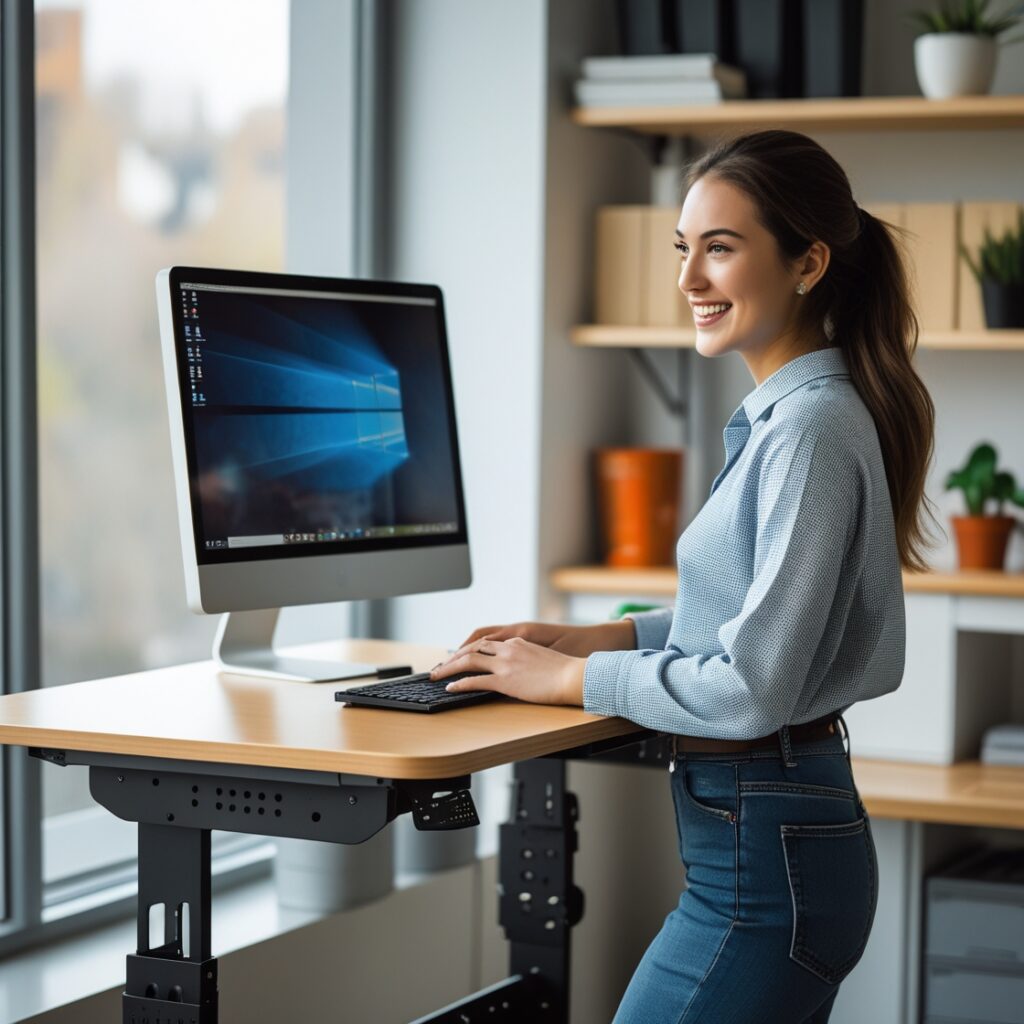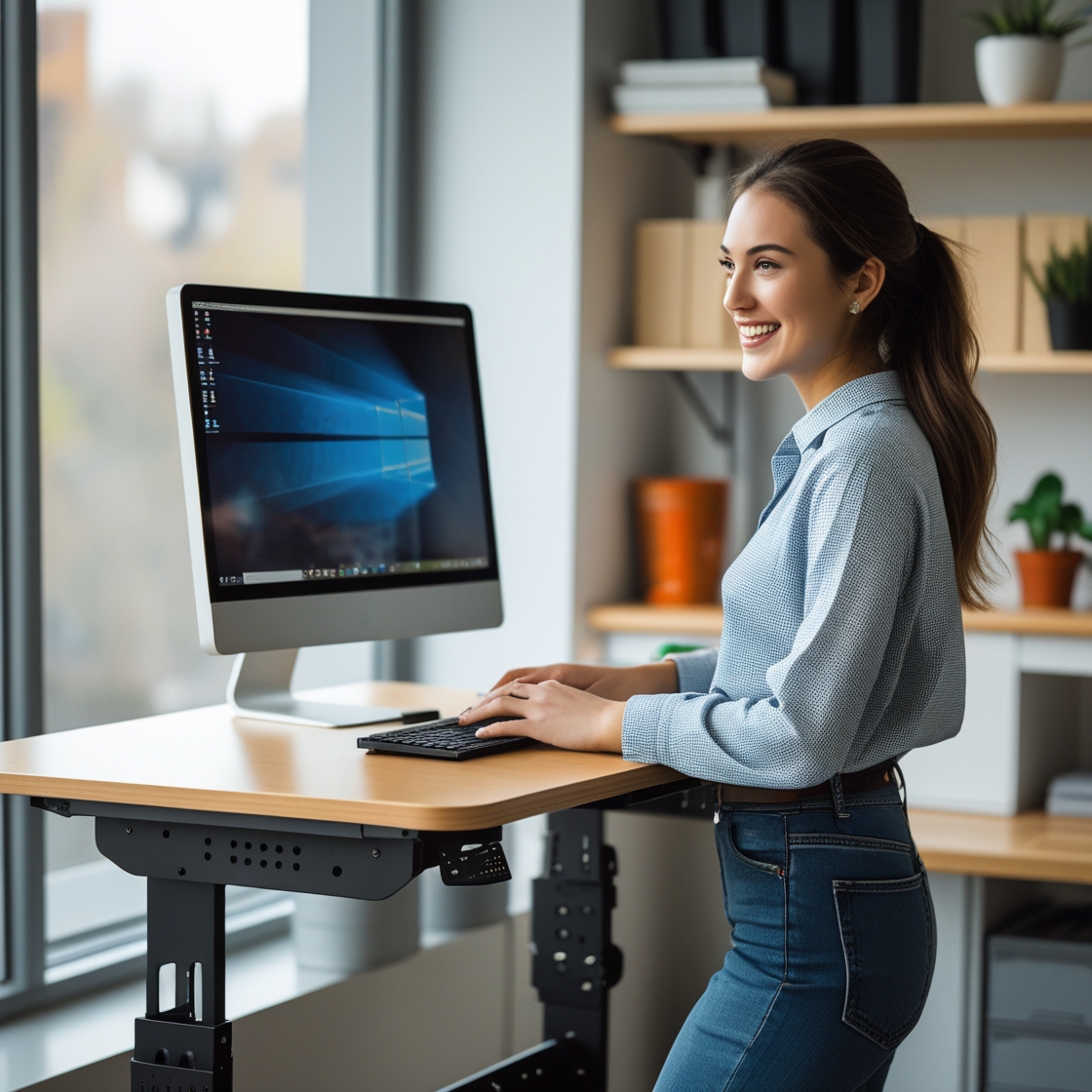
Standing Desks: Are They Really Better for Your Spine?
Standing desks gained popularity as an alternative to prolonged sitting, with claims they may help with posture and back discomfort. But are they really beneficial? Let’s separate fact from fiction.
SITTING DOWN THE PROBLEMS: WHY SITTING ALL DAY HURTS
Prolonged sitting, especially when slouched, can lead to back and neck pain, and poor posture. It flattens the natural curve of your lower back, increasing pressure on your spine. This extra load on ligaments, discs, and muscles can cause discomfort and pain.
THE SILENT DAMAGE OF DESK-BOUND LIVING:
- Flattened spinal curves create disc pressure
- Forward head posture strains neck muscles
- Inactive core muscles weaken
- Circulation decreases, affecting tissue health
- Muscle imbalances develop
Sitting for long periods can also lead to an exaggerated forward head posture. This places added strain on your spine, affecting muscles, ligaments, and tendons. Over time, this pressure may lead to postural changes and neck issues.
STANDING TALL: UNDERSTANDING STANDING DESKS
A standing desk allows you to work while standing. It can be fixed-height or adjustable. Adjustable desks offer flexibility to switch between sitting and standing. Sit-stand stools or anti-fatigue mats may improve comfort.
THE STANDING DESK ADVANTAGE: POTENTIAL BENEFITS
A standing desk may help counteract some negative effects of sitting:
1. REDUCED SITTING TIME: THE MOVEMENT SOLUTION
Alternating between sitting, standing, and taking breaks may help reduce spinal strain and improve circulation.
2. BETTER SPINAL ALIGNMENT
A correctly adjusted standing desk promotes better posture and reduces slumping and forward head positioning.
3. ACTIVE MUSCLE ENGAGEMENT
Standing activates core and stabilizing muscles, while regular small movements like shifting weight may help reduce discomfort and improve alertness.
4. POTENTIAL RELIEF FOR BACK AND NECK
Less discomfort may be experienced, likely due to reduced spinal pressure and improved posture from standing.
THE OTHER SIDE OF STANDING: POTENTIAL DRAWBACKS
Prolonged standing can have its own challenges:
- Not All Standing Is Equal: Just like prolonged sitting, prolonged standing can lead to lower back and neck pain
- Setup Matters: Desks that are too high or low, or not set up correctly can cause musculoskeletal strain
- Lower Body Stress: Standing for extended periods may cause foot, knee and leg discomfort, though supportive footwear or anti-fatigue mats may help
- No Magic Solution: A standing desk is not a substitute for regular movement and general spinal care
THE ERGONOMIC SWEET SPOT: OPTIMAL DESK SETUP
FOR STANDING CONFIGURATION:
✓ Monitor at eye level ✓ Keyboard and mouse within easy reach ✓ Feet shoulder-width apart ✓ Anti-fatigue mat for comfort ✓ Supportive footwear
FOR SITTING CONFIGURATION:
✓ Chair supports lumbar curve ✓ Feet flat on floor or footrest ✓ Wrists neutral when typing ✓ Monitor arm’s length away
BEYOND THE STANDING DESK: HOLISTIC SPINE CARE
Good spinal health goes beyond just standing. The key components include:
- Regular Movement – Take micro-breaks every 20-30 minutes
- Strategic Stretching – Target key areas (hip flexors, chest, shoulders)
- Exercise Routine – Strengthen core and postural muscles
- Posture Awareness – Check and correct throughout the day
- Professional Assessment – Regular chiropractic evaluation
YOUR PERSONALISED WORKPLACE WELLNESS PLAN
At Adam’s Back, we understand that every body is different. We can help you:
- Evaluate your current workstation setup
- Develop an optimal sit-stand routine
- Create a personalised exercise program
- Address any existing postural issues
- Provide ongoing support for workplace wellness
THE 30-30-30 RULE FOR WORKPLACE WELLNESS
OPTIMISE YOUR WORKDAY IN 90-MINUTE CYCLES
CYCLE 1 (First 30 Minutes)
SITTING PHASE
- Start with focused work in proper sitting posture
- Chair supports natural spine curve
- Feet flat, shoulders relaxed
- Monitor at eye level
CYCLE 2 (Next 30 Minutes)
STANDING PHASE
- Transition to standing desk
- Weight evenly distributed
- Gentle weight shifts every few minutes
- Continue productive work
CYCLE 3 (Final 30 Minutes)
MOVEMENT PHASE
- Standing or sitting with frequent movement
- Take micro-breaks for stretching
- Walk to colleagues instead of emailing
- Hydrate and reset posture
BONUS: The 20-20-20 Eye Rule
Every 20 minutes, look at something 20 feet away for 20 seconds to reduce eye strain.
New to standing desks?
1-Week Standing Desk Transition Plan”:
- Day 1-2: Stand for 30 minutes every 2 hours
- Day 3-4: Stand for 45 minutes every 2 hours
- Day 5-7: Implement 30-30-30 rule
Red Flags to watch for!
~ Persistent pain despite ergonomic changes
~ Numbness or tingling in hands/arms
~ Recurring headaches
~ Sleep disruption due to discomfort
DESK EXERCISE QUICK HITS:
- Neck Turns – 10 slow turns in each direction
- Shoulder Shrugs – 10 repetitions
- Wrist Circles – 10 each direction
- Ankle Pumps – 10 up and down
- Spinal Twist – 5 each side while seated
“Movement is medicine for your spine – small, frequent changes make big differences!”
TAKE THE NEXT STEP TOWARD WORKPLACE WELLNESS
Don’t let desk life dictate your spine health. Whether you have a standing desk or not, proper assessment and guidance can make all the difference.
Book a workspace ergonomic assessment at Adam’s Back. Call 03-5986-5700 or visit us at 881 Point Nepean Road in Rosebud. Book online at adamsback.com.au
Education purposes only. Please consult with your chiropractor for personal recommendations.


Comments are closed